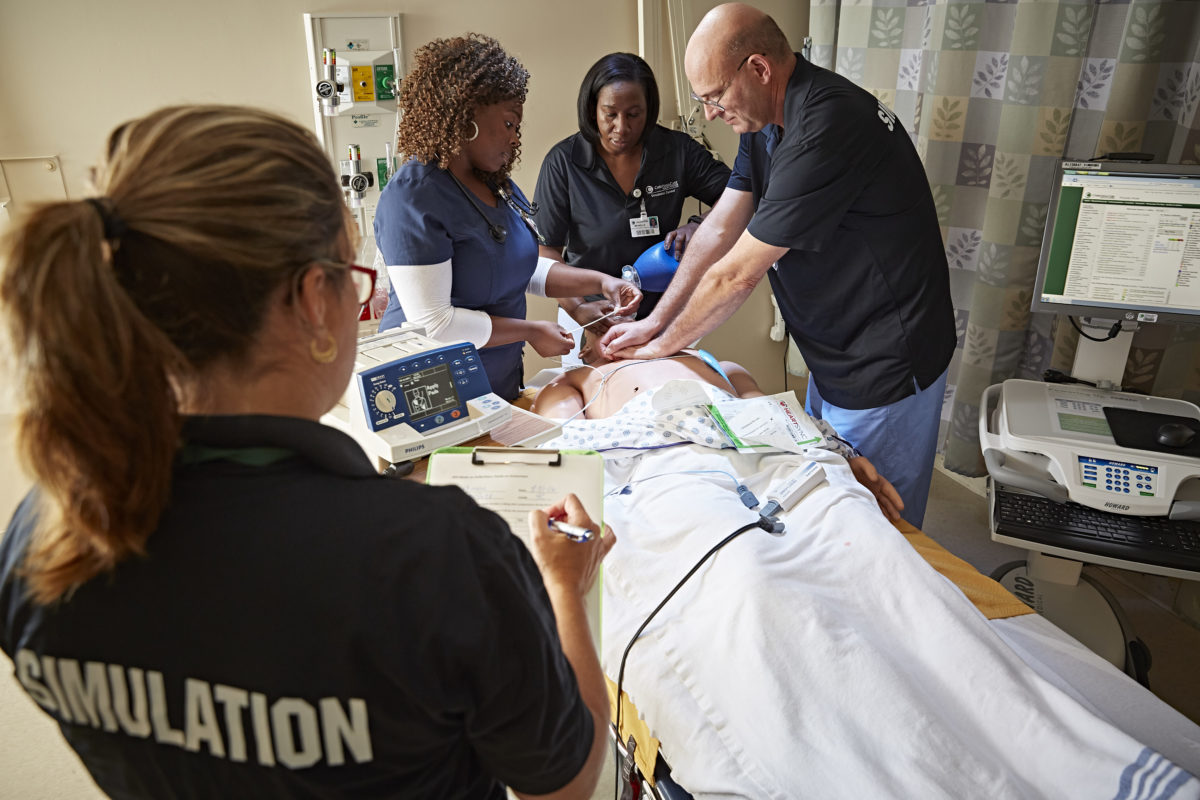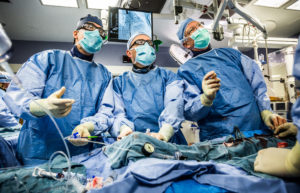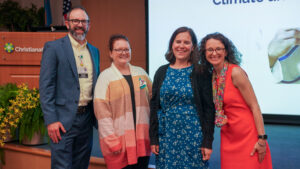When a Code Blue is called, signalling a person experiencing cardiac arrest, Christiana Care’s specialty code team is on its way. The team arrives quickly at the patient’s side, and when they arrive, two vital resources are already on the scene: the bedside nurse and an automated external defibrillator, or AED.
With the touch of a finger, the nurse can change the code cart’s automated external defibrillator (AED) from a monitoring tool to an assessment tool to evaluate the patient’s heart rhythm and, if appropriate, provide a life-saving shock to the patient’s heart.
That technology is being used to its full capacity thanks to a recent real-time study of codes by Christiana Care’s Institute for Learning, Leadership and Development (iLEAD). The study found that although nurses typically start immediate CPR on a patient during a code, the decision on an AED shock came after the code team arrived. Christiana Care’s code cart defibrillators, however, have the ability to automatically assess whether an AED shock is called for.
“These machines are very sophisticated and easy to use,” said Neil Jasani, M.D., MBA, FACEP, Christiana Care’s chief learning officer, chief academic officer and vice president for Academic Affairs. “You just switch them from monitoring to AED mode, and they determine whether a shock is appropriate. Our nurses already know how to use the equipment, so we saw the opportunity to retrain them to immediately switch the machine and, if needed, apply the shock. With this approach, we can significantly cut down time to first shock, which is closely tied to survival rates.”
Real-world assessment and training
The code study was conducted last fall by Christiana Care’s Virtual Education and Simulation Training Center. With the help of two nurses, training personnel set up a high-fidelity mannequin in a hospital bed on a unit at Christiana Hospital and then called a simulated Code Blue. They then videotaped what happened and assessed the response behavior.
What they found was considerable variability in time to first shock, with staff frequently waiting for the full code team to arrive rather than seizing the initiative to deliver the shock themselves.
“Our assessment sessions were unannounced, and the rest of the hospital did not know this wasn’t a real patient going into cardiac arrest,” explained Susan Coffey Zern, M.D., CHSE, director of the Virtual Education and Simulation Training Center. “So we believe our data is consistent with what would happen in a real code.”
Dr. Zern and her colleagues developed a two-pronged approach to re-training. They first sent a web-based module on basic life support training to refresh nurses throughout the health system. Then they brought a high-fidelity mannequin to patient care units at Wilmington and Christiana hospitals for hands-on sessions in use of the AED equipment.
In November and December 2015, some 20 simulation-trained facilitators instructed a total of 1,185 nurses over just four weeks. The trainers employed the deliberate-practice instruction method, which provided repeated opportunities to deliver an AED shock to the mannequin in a simulated high-stress environment, followed by performance assessments until all nurses attained 100 percent success.
“Having people practice and redo their skills until everyone was 100 percent was very important,” said Dr. Coffey Zern. “This was not just checking people off on a list. This was training to mastery of the skill in an environment that felt very real.”
“Through innovative use of technology, we were able to implement a system change based on an assessment of current process, and the benefit supports the optimal health of our patients,” added Dr. Jasani. The training is now integrated into all new nurse orientation. “It’s a great success story.”
Empowered to excel
“The training made me feel empowered,” said Lateshsha R. Collick, MHA, BSN, CNOR, nurse manager of the endoscopy suite. “The team took us through several cycles of shocks back-to-back until we felt comfortable. They really personalized the training and stuck with us until we fully understood how to utilize all of our resources in the appropriate way.”
The training initiative reduced the nurses’ time to first shock from as much as seven minutes to less than a minute-and-a-half, which beats the American Heart Association’s Get with the Guidelines standard of two minutes.
The AED response training stands to further Christiana Care’s excellence in providing the highest quality, evidence-based treatment. Its real-world application is already demonstrating benefits.
“The very next day after our training, we had an actual patient code,” Collick said. “We immediately got the pads on and flipped the machine into automatic mode. In that case it turned out that we didn’t need to shock the patient, but we did two cycles of CPR and got our patient back. We felt very successful.”


